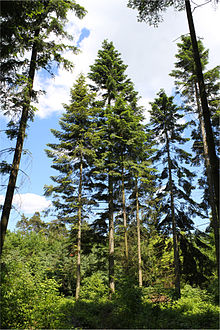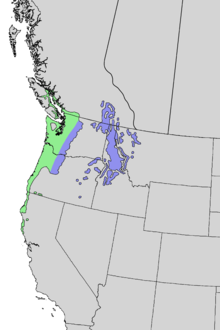| Abies grandis Grand fir | |
|---|---|

| |
| Scientific classification | |
| Kingdom: | Plantae |
| Clade: | Tracheophytes |
| Clade: | Gymnospermae |
| Division: | Pinophyta |
| Class: | Pinopsida |
| Order: | Pinales |
| Family: | Pinaceae |
| Genus: | Abies |
| Species: | A. grandis
|
| Binomial name | |
| Abies grandis | |

| |
| Natural range of Abies grandis
green - A. grandis ssp. grandis
blue - A. grandis ssp. idahoensis
| |
Abies grandis (grand fir, giant fir, lowland white fir, great silver fir, western white fir, Vancouver fir, or Oregon fir) is a fir native to northwestern North America, occurring at altitudes of sea level to 1,700 metres (5,600 ft). It is a major constituent of the Grand Fir/Douglas Fir Ecoregion of the Cascade Range.
The tree typically grows to 40–70 m (130–230 ft) in height, and may be the tallest Abies species in the world. There are two varieties, the taller coast grand fir, found west of the Cascade Mountains, and the shorter interior grand fir, found east of the Cascades. It was first described in 1831 by David Douglas.[3]
It is closely related to white fir. The bark was historically believed to have medicinal properties, and it is popular in the United States as a Christmas tree. Its lumber is a softwood, and it is harvested as a hem fir. It is used in paper-making, as well as construction for framing and flooring, where it is desired for its resistance to splitting and splintering.
- ^ Farjon, A. (2013). "Abies grandis". IUCN Red List of Threatened Species. 2013: e.T42284A2969709. doi:10.2305/IUCN.UK.2013-1.RLTS.T42284A2969709.en. Retrieved 12 November 2021.
- ^ NatureServe (2024). "Abies grandis". Arlington, Virginia. Retrieved 7 September 2024.
- ^ Cite error: The named reference
whitefirwas invoked but never defined (see the help page).

